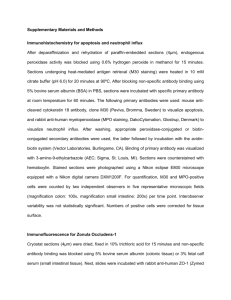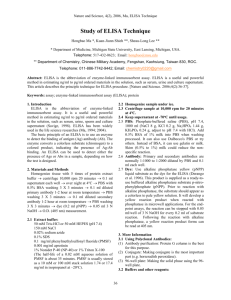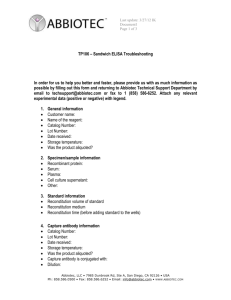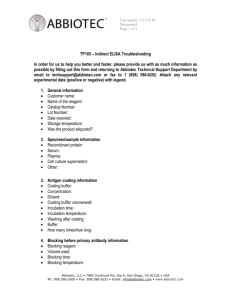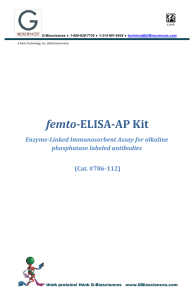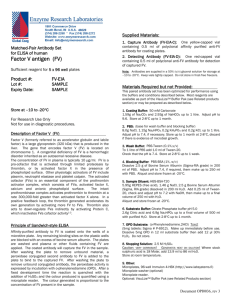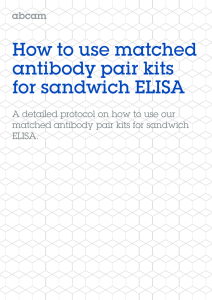hep26664-sup-0000-suppinfo01
advertisement
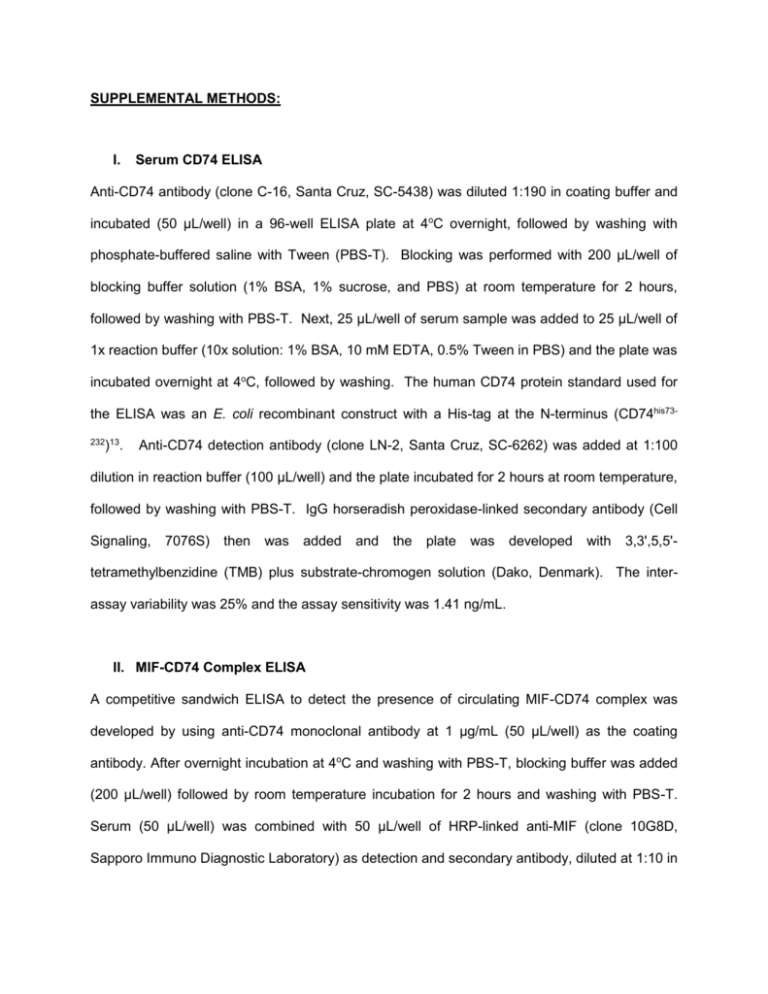
SUPPLEMENTAL METHODS: I. Serum CD74 ELISA Anti-CD74 antibody (clone C-16, Santa Cruz, SC-5438) was diluted 1:190 in coating buffer and incubated (50 μL/well) in a 96-well ELISA plate at 4oC overnight, followed by washing with phosphate-buffered saline with Tween (PBS-T). Blocking was performed with 200 μL/well of blocking buffer solution (1% BSA, 1% sucrose, and PBS) at room temperature for 2 hours, followed by washing with PBS-T. Next, 25 μL/well of serum sample was added to 25 μL/well of 1x reaction buffer (10x solution: 1% BSA, 10 mM EDTA, 0.5% Tween in PBS) and the plate was incubated overnight at 4oC, followed by washing. The human CD74 protein standard used for the ELISA was an E. coli recombinant construct with a His-tag at the N-terminus (CD74his73232 13 ) . Anti-CD74 detection antibody (clone LN-2, Santa Cruz, SC-6262) was added at 1:100 dilution in reaction buffer (100 μL/well) and the plate incubated for 2 hours at room temperature, followed by washing with PBS-T. IgG horseradish peroxidase-linked secondary antibody (Cell Signaling, 7076S) then was added and the plate was developed with 3,3',5,5'- tetramethylbenzidine (TMB) plus substrate-chromogen solution (Dako, Denmark). The interassay variability was 25% and the assay sensitivity was 1.41 ng/mL. II. MIF-CD74 Complex ELISA A competitive sandwich ELISA to detect the presence of circulating MIF-CD74 complex was developed by using anti-CD74 monoclonal antibody at 1 μg/mL (50 μL/well) as the coating antibody. After overnight incubation at 4oC and washing with PBS-T, blocking buffer was added (200 μL/well) followed by room temperature incubation for 2 hours and washing with PBS-T. Serum (50 μL/well) was combined with 50 μL/well of HRP-linked anti-MIF (clone 10G8D, Sapporo Immuno Diagnostic Laboratory) as detection and secondary antibody, diluted at 1:10 in reaction buffer. The plate was incubated for 2 hours at room temperature and developed with TMB plus substrate-chromogen solution. III. MIF-CD74 epitope and competitive MIF-CD74 binding assays Recombinant CD7473-232 was fused to a noncytolytic form of Fcy2a created by site-directed mutagenesis of the complement (Clq) and FcyRI binding site as describedS1 in a pSecTag2 vector. The fusion product then was sub-cloned into the pET101 expression plasmid (Invitrogen) and the CD7473-232-Fc fusion protein was expressed and purified using the Montage antibody purification kit (EMD Millipore, Germany) followed by dialysis against PBS. The expected 44 kDa product was confirmed by SDS-PAGE and western blotting. For epitope mapping, an overlapping series of 6-10mer MIF peptides were synthesized and immobilized on a high-density biochip (LC Sciences, Houston TX) as previously describedS2. Binding of the CD7473-232-Fc fusion protein to the biochip was performed by incubating 1 μg/mL of CD74 73-232Fc at 25oC for 2 hours, followed by washing and incubation of 10 ng/mL anti-IgG Fc DyLight 649 conjugate (Rockland Immunochemicals, Gilbertsville, PA) in binding buffer at 25oC for 30 minutes. After a second wash, image scanning was performed with PMT 500 in a Cy5 channel. The specificity of CD7473-232-Fc binding to the most reactive peptide was confirmed by adding increasing concentrations of synthetic MIF79-86 to immobilized CD7473-232 and measuring competition with biotinylated MIF as previously describedS3. IV. Cell-culture stimulation of hepatic stellate cells The immortalized human LX2 hepatic stellate cell line was generously provided by Dr. Scott L. Friedman (Mt. Sinai School of Medicine, NY). Cells were cultured in T75 flasks using Dulbecco’s Modified Eagle Medium with glutamax (Gibco, NY), 1% penicillin-streptomycin, and 5% FBS. Once confluent, cells were treated with 0.05% trypsin, counted and plated in 60 mm wells (1x106 cells/well). After overnight incubation, media was changed to 0.5% FBS. Cultures were stimulated with 200 U/mL (20 ng/mL) of IFN-γ (R&D, Minneapolis, MN) and supernatants collected followed by lyophilization and western blotting. Prior to collection of supernatants, direct examination showed no loss of cells from the plate surface. V. Whole liver lysate analysis Healthy human liver tissue was collected at the time of surgical resection and snap frozen for storage at -80oC. The tissue was confirmed as normal by a clinical pathologist. An aliquot of tissue was then processed for whole liver lysate using a buffer solution containing 10 mM TrisHCL, 10 mM KCl, 1.5 mM MgCl2, 2 mM phenylmethylsulfonylfluoride, 0.684 mM EDTA and a protease inhibitor cocktail (Sigma, P-8340). A Dounce homogenizer was used followed by centrifugation at 800xG at 4oC for 20 minutes. The supernatant was then used for western blotting as previously described in the manuscript, using LN-2 detection antibody (Santa Cruz, SC-6262). SUPPLEMENTAL REFERENCES: S1. Zheng XX, Steele AW, Nickerson PW, et al. Administration of noncytolytic IL-10/Fc in murine models of lipopolysaccharide-induced septic shock and allogeneic islet transplantation. J Immunol 1995;154:5590-5600. S2. Leng L, Chen L, Fan J, et al. A small-molecule macrophage migration inhibitory factor antagonist protects against glomerulonephritis in lupus-prone NZB/NZW F1 and MRL/lpr mice. J Immunol 2011;186:527-538. S3. Cournia Z, Leng L, Gandavadi S, et al. Discovery of human macrophage migration inhibitory factor (MIF)-CD74 antagonists via virtual screening. J Med Chem 2009;52:416-424.

